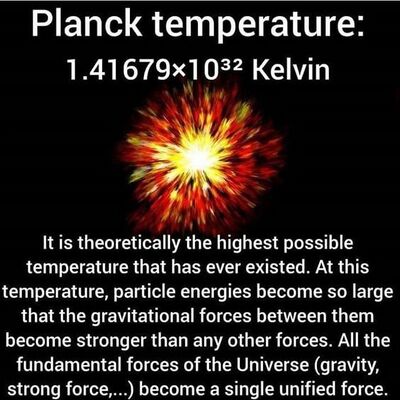The official discord link if you wish to join the discord: https://discord.gg/j5RKwCvAFu
Support the wiki on our official Ko-Fi page or Patreon page!
Planck Temperature: Difference between revisions
GiverOfThePeace (talk | contribs) (→Introduction: clean up and re-categorisation per CFD, replaced: {{Discussions}} →) m |
|||
| (One intermediate revision by the same user not shown) | |||
| Line 1: | Line 1: | ||
[[File:Main-qimg-5445d8a80d77657fdc00046389af9ab7-lq(1).jpg| | [[File:Main-qimg-5445d8a80d77657fdc00046389af9ab7-lq(1).jpg|center|400px]] | ||
==Introduction== | ==Introduction== | ||
The '''[https://en.wikipedia.org/wiki/Planck_units#:~:text=The%20Planck%20temperature%20TP,model%20the%20extreme%20energies%20attained. Planck temperature]''' is '''1.416784(16)×10^32 K'''. At this temperature, the wavelength of light emitted by thermal radiation reaches the Planck length. There are no known physical models able to describe temperatures greater than TP; a quantum theory of gravity would be required to model the extreme energies attained. Hypothetically, a system in thermal equilibrium at the Planck temperature might contain Planck-scale black holes, constantly being formed from thermal radiation and decaying via Hawking evaporation. Adding energy to such a system might decrease its temperature by creating larger black holes, whose Hawking temperature is lower. Physics based on Einstein’s universal model start to come apart at the seams when that temperature is reached. At temperatures that high, particle energies increase to a point where their gravitational forces are as substantial as any other kinds of fundamental forces. Gravity, electromagnetism, strong nuclear forces and weak nuclear forces combine into a single, unified force. | The '''[https://en.wikipedia.org/wiki/Planck_units#:~:text=The%20Planck%20temperature%20TP,model%20the%20extreme%20energies%20attained. Planck temperature]''' is '''1.416784(16)×10^32 K'''. At this temperature, the wavelength of light emitted by thermal radiation reaches the Planck length. There are no known physical models able to describe temperatures greater than TP; a quantum theory of gravity would be required to model the extreme energies attained. Hypothetically, a system in thermal equilibrium at the Planck temperature might contain Planck-scale black holes, constantly being formed from thermal radiation and decaying via Hawking evaporation. Adding energy to such a system might decrease its temperature by creating larger black holes, whose Hawking temperature is lower. Physics based on Einstein’s universal model start to come apart at the seams when that temperature is reached. At temperatures that high, particle energies increase to a point where their gravitational forces are as substantial as any other kinds of fundamental forces. Gravity, electromagnetism, strong nuclear forces and weak nuclear forces combine into a single, unified force. This is essentially the closest thing to the opposite to '''[[Absolute Zero]]''' in theoretical physics. | ||
[[Category:Powers and Abilities]] | [[Category:Powers and Abilities]] | ||
Latest revision as of 20:12, 15 June 2024

Introduction
The Planck temperature is 1.416784(16)×10^32 K. At this temperature, the wavelength of light emitted by thermal radiation reaches the Planck length. There are no known physical models able to describe temperatures greater than TP; a quantum theory of gravity would be required to model the extreme energies attained. Hypothetically, a system in thermal equilibrium at the Planck temperature might contain Planck-scale black holes, constantly being formed from thermal radiation and decaying via Hawking evaporation. Adding energy to such a system might decrease its temperature by creating larger black holes, whose Hawking temperature is lower. Physics based on Einstein’s universal model start to come apart at the seams when that temperature is reached. At temperatures that high, particle energies increase to a point where their gravitational forces are as substantial as any other kinds of fundamental forces. Gravity, electromagnetism, strong nuclear forces and weak nuclear forces combine into a single, unified force. This is essentially the closest thing to the opposite to Absolute Zero in theoretical physics.
